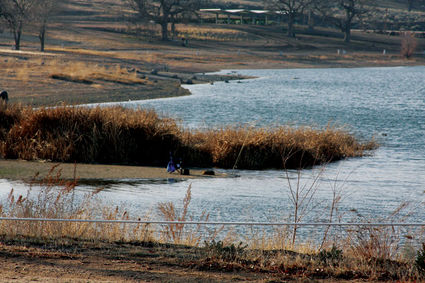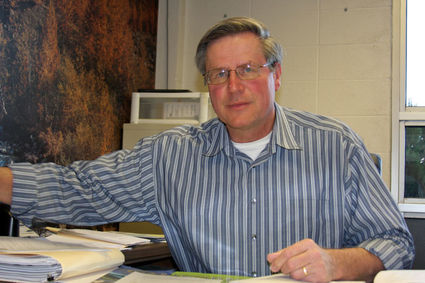Planning Ahead For Water: Brite Lake Will Be Brimming
The Forde Files

Tina Fisher Forde
A fisherman's gear rests on a spit of land exposed by the low water level at Brite Lake (Jacobsen Reservoir), the reservoir for the Tehachapi-Cummings County Water District and recreational playground managed by the Tehachapi Valley Recreation and Park District.
In 2010, the principle water purveyors in the Greater Tehachapi area completed a Regional Urban Water Management Plan. In it, the Tehachapi-Cummings County Water District as Watermaster, the city of Tehachapi and the Golden Hills, Stallion Springs and Bear Valley community services districts mapped out a long-term plan for water management and conservation.
The State Water Project's Jan. 31 declaration of a zero allocation for all its customers was not on the radar when that report was written. Never in its 54-year history has the SWP issued a zero allotment.
"We were required [by the state] to plan for different scenarios," water district Manager John Martin said. "We planned for a drought with six percent allocation. We planned for three years at 25 percent. Here it's zero. It's worse than the worse-case scenarios."
The zero allotment came as a surprise, Martin said. Governor Jerry Brown had declared a drought just three weeks before that announcement.
Usually, Martin said, the expectation is for rain and snow in January, and it is unusual to declare a lower allotment in mid-winter. The original allotment for the year had been five percent – not enough for the district – and the next announcement had been expected to be higher.
On a normal year, the district brings 8,000 acre feet of water up the hill from the California Aqueduct. Even with a zero allocation, the district will pay $2.1 million for no water, as the district is obliged to pay its share of the SWP bond debt service.
To get through the drought, the water district is planning to utilize some old, unused wells, to fill Brite Lake (Jacobsen Reservoir) and to receive "a little" leftover 2013 water from the State Water Project. "There is water in San Luis Reservoir we can use," Martin said.
The district also has water banked with the West Kern Water District and Kern Water Bank.
Jacobsen Reservoir, which is kept low on purpose to reduce evaporation and seepage, will look a lot different soon.
"We are going to be filling it up to the tippy top," Martin said. "We're filling the reservoir to provide more water for the peak agricultural demand this summer."
The district plans to provide the Tehachapi farmers with surface water in order to keep the ground water levels high.
"We want to keep the farmers off the ground water as long as we can," he said.

Tina Fisher Forde
Water district Manager John Martin, left, said the reservoir will be filled to the top in a pro-active move to maintain water resources during the drought. The level will rise far above its present level, covering muddy shoreline and re-floating the grounded boat ramp.
The Tehachapi ground water basin reaches 10 miles east to west and six miles north to south.
The Cummings Basin is 13 square miles (roughly four by three miles).
Brite Basin is approximately one-third the size of Cummings Basin.
However, Martin said, "If there is no rainfall for another year, it could get critical."
Residential water for the city and county areas is from wells, which emerges clean from the earth after being filtered through layers of sand and rocks.
"For all the wells, the only treatment is low level chlorine," Martin said.
All the snow on the mountains surrounding Tehachapi does not refill the aquifers naturally.
"The native vegetation uses 90 percent of the water that falls," Martin said. "That's why the trees grow up there."




